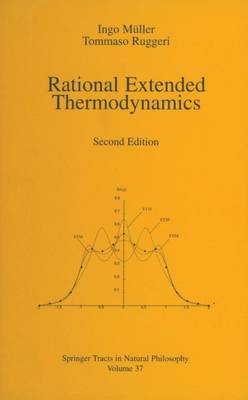Springer Tracts in Natural Philosophy S.
2 total works
v. 37
Ordinary thermodynamics provides reliable results when the thermodynamic fields are smooth, in the sense that there are no steep gradients and no rapid changes. In fluids and gases this is the domain of the equations of Navier-Stokes and Fourier. Extended thermodynamics becomes relevant for rapidly varying and strongly inhomogeneous processes. Thus the propagation of high frequency waves, and the shape of shock waves, and the regression of small-scale fluctuation are governed by extended thermodynamics. The field equations of ordinary thermodynamics are parabolic while extended thermodynamics is governed by hyperbolic systems. The main ingredients of extended thermodynamics are • field equations of balance type, • constitutive quantities depending on the present local state and • entropy as a concave function of the state variables. This set of assumptions leads to first order quasi-linear symmetric hyperbolic systems of field equations; it guarantees the well-posedness of initial value problems and finite speeds of propaga tion. Several tenets of irreversible thermodynamics had to be changed in subtle ways to make extended thermodynamics work. Thus, the entropy is allowed to depend on nonequilibrium vari ables, the entropy flux is a general constitutive quantity, and the equations for stress and heat flux contain inertial terms. New insight is therefore provided into the principle of material frame indifference. With these modifications an elegant formal structure can be set up in which, just as in classical thermostatics, all restrictive conditions--derived from the entropy principle-take the form of integrability conditions.
v. 37
Physicists firmly believe that the differential equations of nature should be hyperbolic so as to exclude action at a distance; yet the equations of irreversible thermodynamics - those of Navier-Stokes and Fourier - are parabolic. This incompatibility between the expectation of physicists and the classical laws of thermodynamics has prompted the formulation of extended thermodynamics. After describing the motifs and early evolution of this new branch of irreversible thermodynamics, the authors apply the theory to mon-atomic gases, mixtures of gases, relativistic gases, and "gases" of phonons and photons. The discussion brings into perspective the various phenomena called second sound, such as heat propagation, propagation of shear stress and concentration, and the second sound in liquid helium. The formal mathematical structure of extended thermodynamics is exposed and the theory is shown to be fully compatible with the kinetic theory of gases. The study closes with the testing of extended thermodynamics through the exploitation of its predictions for measurements of light scattering and sound propagation.

